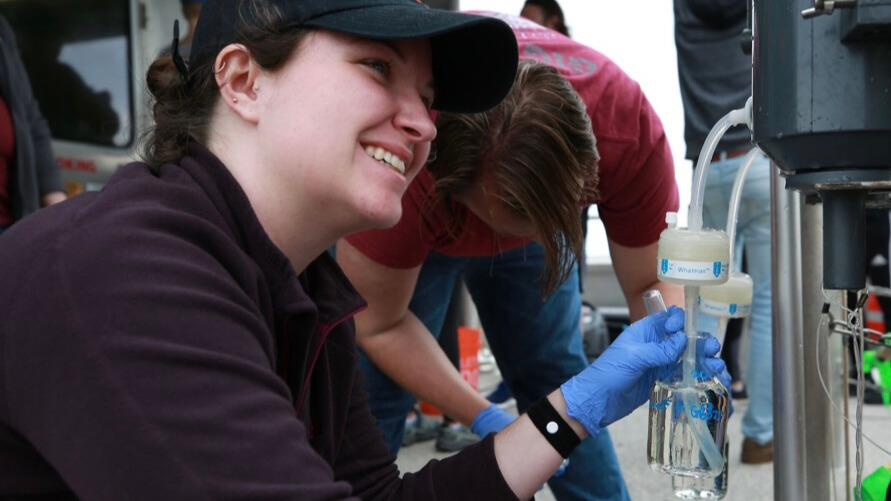The Reeftastic Voyage: A fellow’s journey from landlocked Montana to the sea
Selected as a 2023 Knauss Fellow, Dr. Tacey Hicks brought her chemistry background to NOAA’s National Ocean Service, bridging science and policy. Her path—from diving in Australia to researching reef ecosystems—led to a pivotal career shift connecting ocean science with national policy.
Aug 25, 2025 By Nicolas Perez Communications Specialist
8 minutes
 Dr. Hicks taking samples during her research.
Dr. Hicks taking samples during her research.Named in the honor of one of Sea Grant’s founders, the John A. Knauss Marine Policy Fellowship Program is an educational experience for graduate and professional students with an interest in ocean, coastal, and Great Lakes resources and the national policy decisions affecting those resources. This program has seen many fellows go on to have careers in federal agencies, higher education institutions, or non-governmental organizations related to coastal or marine resources or policies.
In 2023, Tacey Hicks was selected as a Knauss Fellow and placed in the National Oceanic and Atmospheric Administration’s (NOAA) National Ocean Service, serving in the Policy and Constituent Affairs Division (PCAD). As the Ocean and Coastal Policy Analyst, Hicks worked alongside two cross-functional teams, the NOAA Offshore Wind team and the NOAA Tribal team. Additionally, she worked as a NOAA representative for the Ocean Resources Management Subcommittee, colloquially referred to as ORM. During her fellowship, Hicks was one of the few who concurrently defended a Ph.D. while in the program.
Hicks’ experience in the Knauss Fellowship Program became a pivotal chapter in her path toward a career in ocean and coastal policy.
Avogadro at Sea
While pursuing a degree in traditional chemistry at Montana State University, Tacey Hicks found that chemistry just clicked for her. A passionate and supportive professor helped support her interest. Still, she wanted to find different ways to apply chemistry in a career.
During a year abroad in Australia, she continued taking chemistry courses and went diving for the very first time. This dive would spark her interest in oceanography.
Back in Montana, Hicks realized she missed the sense of community she experienced when diving. “Most serious divers are very conscious about the environment, very conscious about the ‘leave no trace,’… and I really liked that community aspect,” she said. The experience gave her a new perspective on a more out-of-the-box career in chemistry, specifically, studying chemistry in the ocean.
With that goal in mind, Hicks began searching for avenues to study chemistry in the ocean. While digging through weeds of online searches, Hicks discovered a lab studying ocean acidification. This was just the beginning. Opportunities for niche applications of chemistry were on the horizon and she was determined to reach them. She started emailing professors, including the one involved with the study she initially found, to ask how she could get involved. In the meantime, she participated in “snow science,” studying the microbiology of glaciers.
Anne Cohen, Ph.D., a scientist from Woods Hole Oceanographic Institution, was the first to respond with an opportunity. Under Dr. Cohen’s mentorship, Hicks studied the impacts of climate change on marine calcification, which naturally includes coral reefs and shellfish, since both rely on calcium carbonate to build their skeletons and shells, making them particularly sensitive to changes in ocean chemistry. This research opportunity was like a drop in the ocean. Though modest, it would prove to have a ripple effect that would eventually steer her toward the Knauss Fellowship.
Another professor Hicks had emailed was Katie Shamberger. Dr.Shamberger is a Chemical Oceanographer and Associate Professor Emerita at Texas A&M University. At the time, Shamberger did not have an opening for Hicks, but fate had other plans. Dr. Cohen had been Dr.Shamberger’s postdoctoral advisor. Those threads soon entwined, and Dr. Shamberger would eventually become Hicks’ Ph.D. adviser. It was here, through Texas A&M, that Hicks was introduced to Texas Sea Grant and the John A. Knauss Marine Policy Fellowship Program.
A Fellow in the Ocean
While interning at Woods Hole Oceanographic Institution during her undergraduate years, Hicks met a student who had been accepted into the Knauss Fellowship. At the time, she didn’t fully understand the program and could not see herself benefiting from it due to her chemistry interest, and Knauss being largely policy and management. Over time, that changed. She found herself wanting to do something outside of the traditional academic track and beyond the industry track many scientists follow. Hearing from others who applied science in the realm of policy, encouraged her to give policy a try.
Hicks set her sights on acceptance into the Knauss Fellowship program. During the selection process, candidates interview for multiple positions. Hicks prioritized policy-oriented roles, hoping to explore how policy connects science to research.
She wanted her experience to give her the most benefit for her background in chemistry, so she positioned herself to better align with science and research in her application, as opposed to Oceanography. As a result, Hicks was stationed in NOAA’s National Ocean Service in the Policy and Constituent Affairs Division (PCAD) as an Ocean and Coastal Policy Analyst. There, she handled congressional requests, tracked ocean service information across NOAA and external partners, connected projects and teams, and staffed leadership which included writing talking points, briefing memos and other documents. The role allowed her to bridge her scientific expertise with the policy world.
Furthermore, Hicks worked in the NOAA Offshore Wind Team, the NOAA Tribal team and tangentially, the Ocean Resources Management Subcommittee. The NOAA Offshore Wind team was a constantly evolving environment since it was a relatively new cross-functional program. Hicks described her position with the team as one of the more difficult aspects of her fellowship because she had no prior experience with offshore wind. Difficulty aside, she found the work fascinating, drawn by its complexity from an oceanic perspective.
The Tribal Team’s work resonated with her because she had previously worked on indigenous projects in Hawaii. She valued learning how tribal knowledge was being integrated into NOAA’s work. Through the Ocean Resources Management Subcommittee, she saw national-level efforts in action, including contributing to the White House Ocean Climate Action Plan.
From the Gulf Coast to the North Pacific
While serving her fellowship, Hicks also defended her Ph.D., which spanned two vastly different ecosystems, oyster reefs along the Texas Gulf Coast and deep-sea coral reefs atop seamounts in the North Pacific. Her research was focused on how climate change impacts the carbonate chemistry of reef ecosystems.
During Hicks’ first week of graduate school, Hurricane Harvey slammed the Texas Coast. The storm shaped the direction of her research, driving her focus toward the oyster reefs of Galveston and how such coastal ecosystems respond to extreme weather. She built on preliminary studies suggesting that major storms could significantly alter acidification levels. Hicks noted that the storm had “the potential to cause a widespread and prolonged shift toward a more acidic environment, which is potentially harmful for regrowth of reefs and traumatic for both larval dispersal and growth.”
In the North Pacific, Hicks’ research on seamounts aimed to answer questions such as how the acidification state of these deep-ocean reef ecosystems could be characterized over time and how changes might affect their long-term persistence. For this reason, she approached this portion of her work more like a case study than a traditional hypothesis-driven experiment, exploring the ecosystem without a predetermined expectation to prove or disprove.
Now, Dr. Tacey Hicks sees the fellowship as a gateway to exploring career paths beyond traditional academia. Through her research on both coastal and deep-sea reef ecosystems, she has found a path that aligns with her interests and hopes to continue pursuing it. While her dissertation remains under embargo at the time of writing, some of her work on oysters and deep-sea coral represents key contributions to her Ph.D. research.
####
About the Sea Grant John A. Knauss Marine Policy Fellowship Program
Established in 1979, the Sea Grant John A. Knauss Marine Policy Fellowship connects graduate and professional students with federal government offices in Washington, D.C., for a one-year, paid policy experience. Named for Sea Grant founder John A. Knauss, the fellowship supports students interested in ocean, coastal, and Great Lakes policy. Texas Sea Grant has consistently placed fellows in agencies such as the National Oceanic and Atmospheric Administration, the National Science Foundation, and the National Aeronautics and Space Administration. Hicks was a participant from 2023 to 2024.
About Texas Sea Grant
Texas Sea Grant is a unique partnership that unites the resources of the federal government, the State of Texas and universities across the state to create knowledge, tools, products and services that benefit the economy, the environment and the citizens of Texas. It is administered through the National Oceanic and Atmospheric Administration and is one of 34 university-based Sea Grant Programs around the country. Texas Sea Grant is a non-academic research center at Texas A&M University. The program’s mission is to improve the understanding, wise use and stewardship of Texas coastal and marine resources.
